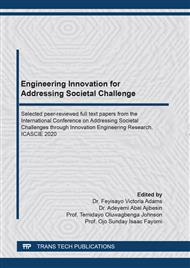p.113
p.122
p.129
p.137
p.144
p.151
p.159
p.174
p.182
Corrosion Studies of Sintered Cobalt-Based Alloys in Sodium Chloride
Abstract:
Cobalt-based alloys have recently gained so much attention in the medical field due to their improved mechanical properties such as wear resistance and high thermal stability. However, limitations in the area of corrosion has posed a great challenge, leading to further studies being carried out on the corrosion resistance of these alloys. In this study, an investigation on the corrosion resistance of Co-Cr-Mo based alloys in 0.9 % NaCl solution was carried at 37 oC and pH of 7.4 using potentiodynamic polarization and chronopotentiometry electrochemical techniques. The surface analysis of the alloys before and after corrosion test was done using scanning electron microscope (SEM). The results obtained from the electrochemical tests showed sample without titanium (Ti) addition to be more resistance to corrosion in the salt solution compared to those containing Ti. It was observed that a decrease in Cr content in the alloys resulted in an increase in corrosion rate from 0.7868 to 1.3805 mpy. The SEM images confirmed the presence of Cr, Co and Mo in the alloys.
Info:
Periodical:
Pages:
144-148
Citation:
Online since:
June 2021
Keywords:
Price:
Сopyright:
© 2021 Trans Tech Publications Ltd. All Rights Reserved
Share:
Citation:


